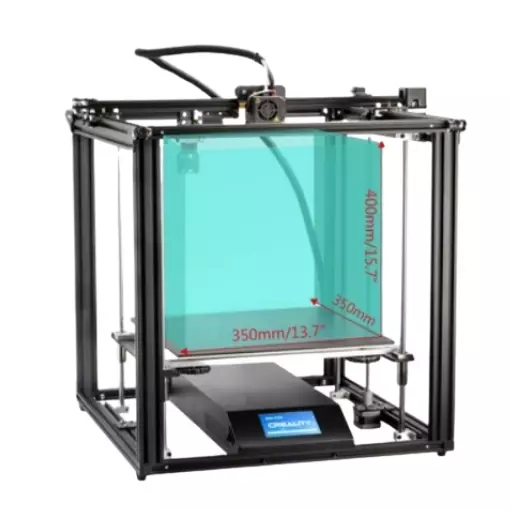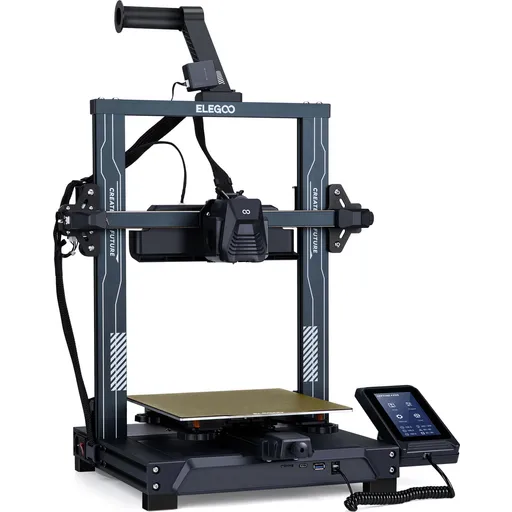Compare Ender 5 Plus vs Neptune 4 PRO
Comparison between the best 3D printers
Choose the best 3D printer at the best price. The cheapest 3D printers are here.
Buy a 3D printer here with 3D Fila.
 |
 |
|
| Model | Ender 5 Plus[BUY Ender 5 Plus] |
Neptune 4 PRO |
| Printing Material | Filament | Filament |
| Buy Filament for Creality 3D Ender 5 Plus | Buy Filament forElegoo Neptune 4 PRO | |
| Estimated price | $599,00 | $359,00 |
| Manufacturer | Creality 3D | Elegoo |
| Release Year | 2019 | 2023 |
| Print Volume [mm] | 350x350x400 | 225x225x265 |
| Printer Size [mm] | 632x619x666 | 475x445x515 |
| Weight [kg] | 18,2 | 8,9 |
| Power Loss Recovery | YES | YES |
| Enclosed printer | NO | NO |
| Bed Leveling | Automatic | Automatic |
| Filament End Sensor | YES | YES |
| Bed type | Heated | Heated |
| Power supply system | Bowden | Direct Drive |
| Standard nozzle | 0,4 | 0,4 |
| Maximum Nozzle Temperature [°C] | 260 | 300 |
| Maximum Bed Temperature [°C] | 100 | 110 |
| Maximum printing speed [mm/s] | 180 | 500 |
| Filament holder | YES | YES |
| Camera for supervision | NO | NO |
| Recommended filaments | PLA, TPU, ABS, PETG | PLA, PLA+, TPU, PETG, Nylon, ABS |
| Recommended slicers | Cura, Simplify, Slic3r | Bambu Studio, Super Slicer, Cura, Prusa Slicer, Orca |
| Maximum Resolution [mm] | 0,1 | 0,1 |
| Processor | 32 bits | ARM 64 bit |
| Display | Touchscreen TFT 4,3'' | Touchscreen 4,3'' |
| Power Supply | 24V / 504W | 310 W |
| Connectivity | SD / USB | USB, microSD |
| Operating systems | Windows, Mac, Linux | Windows, Linux, Macbook |
| Date of registration in the system | 2021-04-14 | 2024-07-02 |
| Release date | 2019 | 2023 |
| Extra features | The Ender 5 Plus offers a large print volume (350x350x400 mm) and fast assembly. It includes a BLTouch sensor, but with range limitations. It stands out for its dimensional accuracy, although it requires adjustments to the slicer settings. Despite the noise, its integrated design saves space, and includes features such as a filament sensor and power resumption. Ideal for large projects, it requires refinement in the settings for high-quality prints. | The Elegoo Neptune 4 Pro stands out for its advanced features, including pre-installed Klipper firmware, a dual-gear direct extruder with a 5.2:1 ratio, a high-temperature nozzle (up to 300°C), a flexible magnetic PEI platform, efficient cooling fans, and a 121-point auto-leveling system. The printer also features a 4.3-inch touchscreen interface, dual linear bars on the X and Y axes, and a segmented heated bed for energy savings. |
| Support for multiple colors and materials (AMS and CFS) | NO | NO |
Notes * |
||
| Cost-benefit | 6 / 10 | 7 / 10 |
| Hardware | 2 / 10 | 3.2 / 10 |
| Tela | . | . |
| Print volume | 4 / 10 | 3 / 10 |
| Performance | 1 / 10 | 4 / 10 |
| [BUY Ender 5 Plus] |
Conclusion |
| In comparing the Ender 5 Plus and the Neptune 4 Pro, it becomes clear that both printers have unique strengths that cater to different needs and preferences in 3D printing. The Ender 5 Plus, released in 2019, offers a generous print volume, making it ideal for larger projects. Its core features include automatic bed leveling and a heated bed, alongside a stable design that enhances dimensional accuracy. However, it demands manual slicer adjustments for optimal quality and is somewhat limited by its nozzle temperature and maximum printing speed. While it is heavier and pricier than its competitor, it does deliver reliable performance, making it a solid choice for users focused on crafting larger designs. On the other hand, the Neptune 4 Pro, newer and more affordable, provides advanced features that appeal to tech-savvy users. It boasts a high maximum nozzle temperature and superior maximum printing speed, enabling faster and potentially more intricate prints. With innovative elements such as a dual-gear direct extruder, extensive auto-leveling capabilities, and a more compact design, it stands out as a modern and efficient option for those keen on maximizing performance without breaking the bank. In summary, the selection between these two printers hinges on user priorities. Those needing larger build sizes and who are willing to invest time in configurations may prefer the Ender 5 Plus. Conversely, users who seek advanced technology, speed, and ease of use at a lower cost might find the Neptune 4 Pro to be the better fit. Overall, both printers offer compelling advantages, reflecting their respective configurations and target user bases. |

